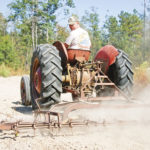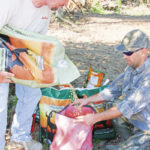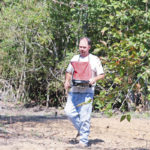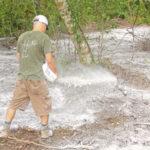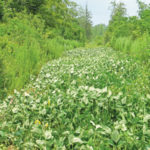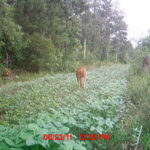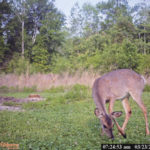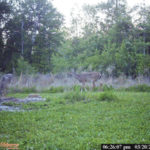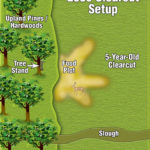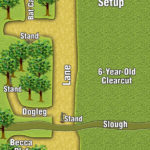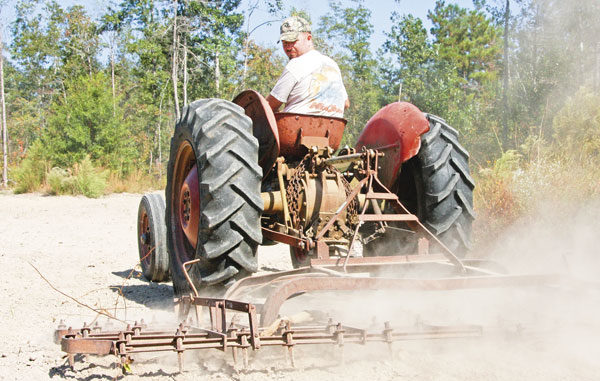
One day’s dozer work radically changed this little slice of Washington Parish.
In a text message on Saturday, Oct. 30, 2010, Todd Masson responded to my “You’ve got to be kidding me,” message that I had just sent him at 7:30 after hearing a shot ring out from his direction, “Three deer were at feeder … Joel shot but I think he missed. He was a nervous wreck.”
Sunrise was at 7:13 that morning.
Another message at 8:07 read, “Just had another deer cross the lane.”
Later that evening, after he and his son Joel Masson settled in
for the afternoon portion of Joel’s youth hunt, Masson texted
me again.
“Started in Bat Cave, but wind switched and blew straight into lane. Left to go to Dogleg, but we saw doe and fawn in Becca lane as we were walking. Now we’re in lane … couldn’t resist. It’s almost like a pat on the back for what we’re doing back here.”
My phone announced Masson’s final message to me that
day at 5:21.
“Just watched two feeding in Becca plot,” it read. “They were in lane on far side, and moseyed into hay field, completely ignoring my truck. We’ve see 11 deer today … I feel like I’m in
West Texas.”
I would like to say that’s how our 2010-11 deer season began on the small parcel of land in Washington Parish that Masson and I manage together, but their seeing 11 deer on last season’s youth hunt started way before that.
Masson and I have been working together to try to turn some of my family property in rural Washington Parish into a deer magnet. We’ve been documenting what we’ve done all along the way since this project was birthed three years ago.
Since our little plots were so small the first year we started
working this property, we decided to call the story about this project “Postage Stamp Plots.” Last August, we followed up with Postage Stamp Plots II, and now we’re following that with Postage Stamp Plots III.
We’ve made a lot of improvements in three years with last
season’s youth day being somewhat of a culmination of our
three-year effort. In 2008, we would have considered ourselves fortunate to see one deer, and now Masson, tongue-in-cheek, was texting me that he felt like he was hunting
West Texas.
Our first year of deer management was based on getting by on the cheap. But like an addict gets hooked by just a taste, our addiction has spiraled out of control. Last season, no longer were we content to scratch the ground with a disk pulled by a 1965 Massey Ferguson, throw some seed by hand and drag the harrow.
The plot behind my house that we called the Clearcut plot and the plot behind my brother’s house that we called the Cemetery plot had grown just a little bit in size between year one and year two. Last year, we decided that two small plots wasn’t enough, and we made the decision to bring in
a bulldozer to do some work on the Clearcut plot behind
my house.
I go to church with Keith Voth, who owns and operates Keith Voth Dozer and Excavation, and his son Brandon. After many post-church discussions with Brandon, we finally nailed down a date for him to arrive last July with his John Deere D-4 dozer.
What would have taken Masson and me seven months to do with
chainsaws, tractor blades and manual labor, Voth was able to accomplish in seven hours beginning on July 23.
Our goal was to clear a two-dozer wide lane right down the edge of our clearcut and standing timber. And we wanted three smaller lanes cut into the standing timber off of this main lane. The cemetery plot was going to stay as it was.
The end result was magnificent. In the end, we wound up with the main lane, a cove just inside the woods as you walk into the lane that we named the Becca Plot because it would be the easiest for my young daughter to hunt, an angled cut into the timber with a circular landing at its end with a single white oak in the middle of it that we named the Dogleg Plot, and a complex that wound up getting dubbed the Bat Cave because of its circular center with two small spokes and one main lane coming off of it.
Voth had so expertly cleared the ground to the point that it was workable just as soon as he finished. The first deer tracks appeared on July 28, and I went to work on Aug. 4 breaking the new ground with the old Massey Ferguson and dragging it smooth with
the harrow.
I purchased a new compound bow, a Diamond Stud that I fell in love with, from Louisiana Outdoors in Pearl River on Aug. 6, and that only increased our urgency to have
everything ready by Oct. 1 rather than Nov. 21.
Wanting to do everything right, we pulled soil samples from all plots on Aug. 7, and my wife mailed them to Biologic on Aug. 9. I got the soil sample results back three days later on Aug. 12, and over the next few days, Masson and I spread 1,400 pounds of lime in the Bat Cave, 640 pounds on the Dogleg and 640 pounds on a 5,000-square-foot area of the main lane. We also added another 340 pounds of lime to the Cemetery plot.
Deer apparently love the smell of fresh dirt because the main lane behind the house wound up looking like a deer interstate with tracks going up and down the lane while we were working the dirt.
On Sept. 4, Masson and I put up a ladder stand in the Bat Cave, and fertilized all plots to the specifications of the soil test results. We planned on planting the next Saturday, Sept. 11, but that’s when Mother Nature stepped in and started slapping us around.
With no good chance of rain for the next three weeks, we put off planting until Oct. 1, so we obviously didn’t have anything ready but a couple of corn holes come bowseason. We planted several different blends of Plot Spike seed with
a decent chance of rain over the next few days, but that rain never came.
Two tenths of an inch of rain fell on Oct. 11, and another two weeks went by with no rainfall. I decided to replant on Saturday, Oct. 23 because of a better chance of rain over the next few days, and we got a grand total of nine-tenths of an inch over the following Sunday and Monday.
Five days later, during the youth hunt on Saturday, Oct. 30, Masson and his son Joel felt like they were hunting in West Texas. We agreed that those 11 deer weren’t the result of our food plots because those plants were just barely breaking the ground, but we decided that they were the result of expanding the plots behind the house. Deer really loved the open spot on the edge between the clearcut and the standing timber.
All plots were up and green by the opening of gun season on Nov. 20, but we came to the quick realization that we might have planted too much. The clover and oats in the Cemetery plot never got above lip high, but the oats, wheat, clover and brassicas behind the house showed very little signs of browsing.
Some inspection later in the season revealed that deer were eating behind the house, but they were eating in little nooks and crannies off of Becca, the Dogleg and the Bat Cave.
We planted so much that deer weren’t drawn to one particular area. Therefore, choosing which stand to hunt became a crap-shoot because deer could have literally come out anywhere rather than to one confined spot.
After allowing quite a few deer to walk, I never could pull the trigger on a doe despite my promise in “Postage Stamp Plots II.” We wrapped up the season with Masson shooting a doe and his daughter Taylor killing a spike on the new main lane behind the house, and my nephew Karlton killing a spike on the Cemetery plot.
I received this text from Masson at 8:33 in the morning on Dec. 12 after I noticed that his truck was already gone when I woke up and peaked out the back door.
“Amazing hunt!” he began. “On stand five minutes and deer came out at trail. Set daughter up, and she dropped it in its tracks. She was more excited than I’ve ever seen her. Turned out to be a spike, but I would have rathered that than me killing a 12-point … I’m at sister’s now cleaning it — didn’t want to wake you up because I knew you had to teach Sunday School.”
We also got started with our spring and summer plots this past April. Despite my family having another 100 acres or so clearcut during the middle of deer season, I decided to go ahead and put about an acre of iron and clay peas in hopes that deer would find them amongst all the new tender shoots in the new cuts.
It took them a little while to grow with the drought conditions Washington Parish experienced during April and May, but a few June rains really made them flourish. The deer started hammering them about the same time the peas put off a flush of new growth.
I also put in about a half acre of American jointvetch and alyce clover the same time I planted the peas. Both have been really slow to get established, but they are beginning to spread out and fill in the main lane in the Bat Cave and the 5,000-square-foot section of the main lane. Deer have already started nibbling the jointvetch, but I’ve seen no sign of browse on the alyce clover as of this writing.
As of this past June, it looked like we had lost the clover plot due to
the drought conditions. Deer continually hammered the clover right up through the end of April when the dry conditions really started taking their toll.
The iron and clay peas, jointvetch and alyce clover should last until the first frost, so that’s going to present a new challenge for Masson and me this deer season.
Do we just let it stand heading into the new season, especially bow
season, and go in with a fall plot after the first frost? Or do we chop it up section by section and go in with fall plots one or two at a time so as not to disrupt their food supply?
For Masson and me, we’ve discovered that debating questions like these and carrying out our plans has become just as addictive, if not more so, than the hunt itself.
